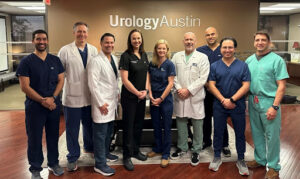The Urology Austin Robotic Surgery Team
Carl Bischoff, MD
Grady Bruce, MD
David Cuellar, MD
Nick Freidberg, MD
Eric Giesler, MD
Brian Mazzarella, MD
Elizabeth Mobley, MD
Robert Northway, MD
Peter Ruff, MD
Kashyap Shatagopam, MD
Herb Singh, MD
Rachel Sosland, MD
Varun Sundaram, MD
Harras Zaid, MD
Urology Austin Robotic Surgery: Bigger and Better
When patients go online to research their urological surgery options, they’ll likely find many robotic surgery practices claiming to be “centers of excellence.” But very few can match the experience and expertise that can be found at Urology Austin.
One of the largest urological robotic surgery practices in the United States, UA is home to 15 intensively trained robotic surgeons who have collectively performed more than 6,000 robotic surgeries since the specialty was launched here in 2004.
No other group in the Central Texas area can match UA’s track record. Our surgeons were the first in the area to perform robotic surgeries and helped develop the robotic programs at many hospitals in the region. Many of our surgeons have given national and international lectures on these surgeries, and surgeons from around the world have visited Austin Urology to observe and learn from our methods and expertise.
“Urology Austin has the most experience with robotic surgery of any practice in this region,” says urological surgeon David Cuellar, MD. “In 2022 alone, we performed 1,135 robotic surgeries. If we have any unusual cases, we talk to each other about them, so patients benefit from the expertise of not just one surgeon but multiple surgeons. Many minds are working on these cases before, during and after surgery.”
More than just a surgery practice
A typical day for our robotic surgeons includes surgeries for a wide variety of urological diseases, including prostate, kidney and reconstructive surgeries. The most common procedures include robotic prostatectomy for prostate cancer, partial nephrectomy for kidney cancer, pelvic floor reconstruction for urinary incontinence, reconstruction after trauma or injury, simple prostatectomy for an enlarged prostate, and cystectomy.
One big benefit of going to a larger, more experienced surgical practice is that patients can be seen and treated much more quickly, and urgent situations can be taken care of with little to no waiting. Patients see the same surgeon throughout their treatment, including through recovery and follow-up visits.
“Patients who are researching their treatment options might assume that going to a large international medical center would be the best option,” says urological surgeon Peter Ruff, MD. “They may be surprised to find that some of the most experienced surgeons in the world are right in their backyard – and with the added benefit of individualized, personal, compassionate care from their actual surgeon, not from a group of fellows, residents and students who may not appreciate an individual patient’s delicate situation.”
UA’s robotic surgery team emphasizes exploring all treatment options to find the one that is the best fit for each person. Often, patients referred to the practice for surgery are relieved to find that surgery isn’t needed after all. For example, in recent years, roughly one-third of men with prostate cancer diagnoses were treated with active surveillance rather than surgery.
State-of-the-art technology
All of UA’s robotic surgeons use the Da Vinci Surgical System, robotic technology that is minimally invasive and highly precise. Additionally, the practice is home to the United States’ top three surgeons specializing in aquablation surgery for benign prostate hyperplasia, or BPH. This FDA-approved surgery uses the AquaBeam Robotic System to deliver a heat-free waterjet to remove prostate tissue overgrowth.
With both types of robotic surgery, patients experience a faster recovery time and much less pain than can be expected with a more invasive type of surgery.
“A lot of patients go home the same day, or at most, stay in the hospital just one night, as opposed to having a multi-day stay,” says urological surgeon Eric Giesler, MD.
The practice employs an enhanced recovery after surgery (ERAS®) protocol that offers non-opioid alternatives for pain control, yet the majority of patients find they don’t need pain medications after surgery, or can simply take over-the-counter Tylenol.
“We are the only fully multidisciplinary team in the area that is able to perform all of these different surgeries and work together to do the best thing for the patient,” says urological surgeon Varun Sundaram, MD.
In fact, the UA robotic surgeons perform more of these surgeries than anyone or any group in the area, and UA has more fellowship-trained urologists and more years of experience than any other Austin urological robotic surgery practice.
“We each have different skill sets and unique talents, so we are always able to provide patients with the best possible care,” says Dr. Giesler. “Since we have a large group of people with extensive skills, I always have a partner who can do a surgery that’s not my specialty. And, I always feel confident that that patient will receive really good care.”


Comments are closed.